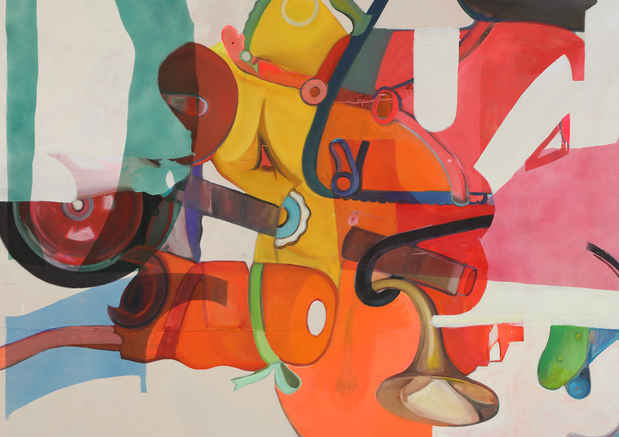Alex Hubbard “In the Near Field”
Galerie Eva Presenhuber

This event has ended.
Eva Presenhuber presents In the Near Field, an exhibition of new works by the American artist Alex Hubbard. In the Near Field is Hubbard’s fourth solo exhibition with Eva Presenhuber and features paintings and a handmade projector playing a unique video.
Contrary to what you might believe, the chief concern in Hubbard’s practice is not painting, its possibilities, and its history; nor is it, as in his videos, the production of comedy glittered with despair. Rather, it is technology, the scientific method, and trying to navigate the wreckage of Modernist reason and logic.
Hubbard’s paintings are material wonders, describing and inscribing the complex processes that eventuate into them as final forms—the mixing and manipulating of various semi-industrial products like resin, urethane, latex, and fiberglass, and the application of semi-industrial processes like UV printing and, in his recent works, the layering of transparent sheets cast from the works topographies’ themselves. In the very latest paintings, Hubbard has turned to applying oil paint atop all this, but that move makes him no less a chemist compared to the typical wielder of sable-tipped brushes.
In his videos, meanwhile, technology is baldly misused. His earlier video works often feature him in the role of scientist-conductor—wearing the occasional lab coat or hazmat suit—of abstruse methodologies and the operation of hysterically jury-rigged contraptions moving toward a punctuating event. In more recent years, his détourned video effects become the protagonists of screwball comedies, flaunting the seams of the work rather than concealing them in favor of the ultra-smooth façade they were designed to create.
In the pre-Enlightenment old days, of course, art and science were not so distinct from one another, and magic not entirely out of the mix. As the old talking point goes, techne, the ancestor of our technology, meant “art.” Art in this sense was any practice that manifests knowledge for use; thus, it could unite science and craft. What renders Hubbard’s elevated tinkering as bastard empiricism is an unexpected resuscitation of the humanist-scientist impulse—timely for a present well past the use-by date of the Modern era but well before any coherence has settled on what lingers and grows after it.
Hubbard’s newest venture, begun in 2019, is a series of homemade video projectors. Instead of a vivid procedural relic or a dramedy about the haphazard nature of trial and error, the endpoint is a teetering, audibly whirring caterpillar of black boxes casting a hazed moving image into the dark. To me, these nondescript objects are Hubbard’s most beautiful, perfectly capturing (1) the sense that all one’s work adds up to so little (2) the fact that contemporary technology has moved past the horizon of an everyday person’s ability to grasp it. It’s no accident that the moving pictures they show, foggy through Hubbard’s homemade urethane lenses have spotlit early Modernist motifs—a de Chirico landscape, a Man Ray metronome, a Picassoid interior with skewed geometry. The reference to these forms is in the mode of comic elegy, imaginatively inhabiting the moment where a sense of discovery, a sense of hope, was still possible.
If you want to get Heideggerian about it, you could say roughly that the clearing of Hubbard’s technological tendencies does the happy opposite of what technologies are intended to do: it does nothing, has no purpose, de-instrumentalizes the world to striking and at-times hilarious results. His projectors have a job to do, theoretically, which is to beam images in the dark, to broadcast illusion; but instead, they expose technology as arbitrary and absurd, subject to mistake and sabotage. Hubbard’s thoroughgoing sense of experimentation is tied to the production of nothing so much as wonder. This humanism begets the work’s impulse toward generosity: In true DIY fashion, the press release for the projectors’ debut offered only their specs, to pool intellectual resources with fellow scientist-masochists instead of mustering them for exploitation.
Alex Hubbard was born in 1975 in Toledo, OR, US, and lives and works in Los Angeles, CA, US. Hubbard has been the subject of solo exhibitions at museums including the Rose Art Museum, Brandeis University, MA, US (2014); Hammer Museum, Los Angeles, CA, US (2012); The Kitchen, New York, NY, US (2010); and Mercer Union, Toronto, ON, CA (2010). Institutional group exhibitions include How We Live: Selections from the Marc & Livia Straus Family Collection, Hudson Valley MOCA, Peekskill, NY, US (2019); Optik Schröder II, Museum Moderner Kunst Stiftung Ludwig Wien, Vienna, AT (2018); The Collection, Marciano Art Foundation, Los Angeles, CA, US (2018); Progressive Praxis, de la Cruz Collection, Miami, FL, US (2017); Single-Channel Catalyst: Alex Hubbard’s ‘Eat Your Friends’ and Selections from the Collection, Weatherspoon Art Museum, Greensboro, NC, US (2016); America is Hard to See, The Whitney Museum of American Art, New York, NY, US (2015); L’Almanach 14, Le Consortium, Dijon, FR (2014); and Knight’s Move, SculptureCenter, New York, NY, US (2010).
Media
Schedule
from April 16, 2021 to May 29, 2021
Opening Reception on 2021-04-16 from 11:00 to 20:00